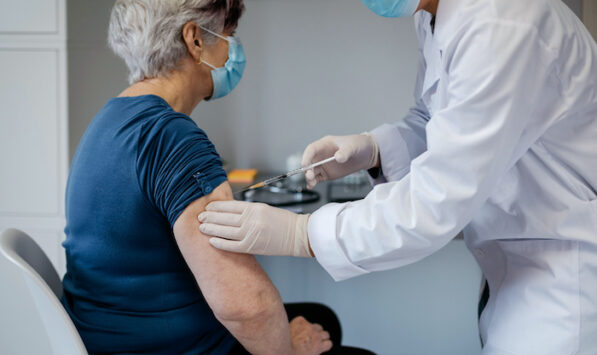
Este artículo estará disponible en español en El Tiempo Latino.
Updated COVID-19 vaccines targeting JN.1-lineage omicron variants of the coronavirus are now available in the U.S. for the fall and winter seasons.
On Aug. 22, the Food and Drug Administration approved and authorized newer formulations of the two mRNA vaccines, from Pfizer/BioNTech and Moderna, for ages 6 months and up. About a week later, the agency authorized an updated version of Novavax’s protein subunit vaccine for people 12 years and older.

The mRNA vaccines specifically target KP.2, a subvariant of JN.1, while the Novavax vaccine targets JN.1.
Following a vaccine advisory committee meeting in late June, the Centers for Disease Control and Prevention recommended that everyone 6 months and older receive an updated vaccine during the fall and winter virus season.
This marks the third year that vaccine manufacturers have updated their COVID-19 vaccine formulations to better match circulating variants. The older versions of the vaccines are no longer available.
Here we answer common questions about the latest vaccines.
- How are these updated shots different from last year’s?
- Who is eligible to get an updated vaccine?
- What evidence supports the use of the updated vaccines?
- How effective are they?
- How safe are they?
- What do experts say about who should get the 2024-2025 vaccines, and when?
- Is one vaccine better than another?
- Are the shots still free, and where can I get one?
- Can I get an updated COVID-19 shot along with other seasonal vaccines?
How are these updated shots different from last year’s?
The new vaccines are nearly identical to their predecessors, except that they now target JN.1-lineage variants of omicron rather than the XBB.1.5 omicron variant. This is akin to a strain change for a seasonal influenza vaccine.
In early June, the FDA’s vaccine advisory committee unanimously voted to recommend that vaccine manufacturers update their COVID-19 vaccines in the fall for JN.1 variants. JN.1 subvariants, including KP.2, were dominant in the U.S. at the time, and it seemed likely that future circulating variants would derive from JN.1. Evidence also indicated that the JN.1 lineage was antigenically very different from XBB.1.5, suggesting an updated formula would be beneficial. About a week later, the FDA expressed a preference for the KP.2 subvariant to more closely match circulating variants.
For the Pfizer/BioNTech and Moderna vaccines, this means that small changes were made to the mRNA in the vaccine so that the sequence now corresponds to the spike protein of the KP.2 variant. The spike protein sits on the outside of the coronavirus and is what the virus uses to enter cells. The mRNA vaccines work by prompting the body to temporarily make its own spike protein, which the immune system then responds to, generating protective antibodies and other immune cells.
For the updated Novavax vaccine, the protein in the vaccine now matches the spike protein of the JN.1 variant. (The Novavax vaccine works in a similar way to the mRNA vaccines — it just skips the step of having cells make spike protein, since the vaccine itself contains protein.) The company did not use KP.2 spike because it was worried it would not have time to make the switch. Protein subunit vaccines take longer to make than mRNA shots.
JN.1 and KP.2 are no longer common variants in the U.S. But as of mid-October, the common ones are closely related to those variants. KP.3.1.1, which CDC models indicated would account for 57% of cases during the two-week period ending Oct. 12, is a descendant of JN.1. The prevalence of KP.3.1.1 has steadily increased, from around 7% in early July to 41% in mid-September. It has been the single-most dominant variant since mid-August.
XEC, a variant that has garnered significant recent media attention and has rapidly spread in Europe, is also a mash-up of two JN.1-lineage variants.
Who is eligible to get an updated vaccine?
Everyone 6 months of age and older is eligible for the mRNA vaccines, while the protein-based Novavax vaccine is available to people 12 years of age and older.
Most people, including those who have not previously been vaccinated, are eligible for a single dose of an updated vaccine, two months or more after a previous COVID-19 vaccination.
Children under the age of 5, however, who have not yet completed a primary course of COVID-19 vaccination should do so. That includes two doses of the updated Moderna vaccine or three doses of the updated Pfizer/BioNTech vaccine, with several weeks to months between doses. People opting for the updated Novavax vaccine who have not previously been vaccinated should get two doses, three to eight weeks apart.
Those who are immunocompromised may receive additional doses.
What evidence supports the use of the updated vaccines?
As it has done for the last two years, the FDA authorized and approved the latest JN.1 vaccines similarly to how it handles seasonal influenza vaccines, which are also refreshed each year to better match the viral strains that are circulating. Because the change is so minor, the agency does not require companies to first test the vaccines in people. Instead, the FDA relies on the wealth of data available on earlier versions of the vaccine.
The agency’s decision was based on a “totality of evidence” that included the original clinical trials; other clinical data from earlier vaccines, which demonstrated that people’s immune responses were sufficient; as well as real-world effectiveness and safety data. The FDA also reviewed nonclinical and manufacturing data specific to the updated vaccines.
In the past, some companies have nevertheless conducted small clinical studies on their updated vaccines (or on versions extremely similar to them). That was not done this year.
In support of the formulation change targeting JN.1-lineage viruses, each company tested their updated vaccine in unvaccinated and previously vaccinated lab animals. They showed that for both groups of animals, the new vaccine prompted a greater neutralizing antibody response to JN.1-lineage variants compared with last year’s vaccine. As the agency explains, this indicates that the new formulations “will likely increase immune responses and protection” to these latest variants.
How effective are they?
There isn’t effectiveness data yet for these updated vaccines, but an analysis of the past two years’ shots showed that compared with no updated vaccine, the shots reduced the risk of a COVID-19-related emergency room or urgent care visit by 43%, hospitalization by 44% and death by 23%.
Protection was generally highest within a month or two after vaccination and declined with time. Compared with no updated vaccine, CDC data indicates that after four to six months, last year’s doses specifically reduced symptomatic infection in adults by about 47%. After two to four months, the vaccines also cut the risk of critical illness by 57%, hospitalization by 43% and an emergency room or urgent care visit by 32%.
It’s important to note that these figures represent the added benefit of getting an updated vaccine against a backdrop of high levels of immunity in the population from both vaccines and infections.
Unless a very different coronavirus variant emerges, experts expect this year’s updated vaccines to perform similar to previous years.
A preliminary, unpublished study from scientists in Germany, for example, found that antibodies in the blood of people who received an updated Pfizer/BioNTech vaccine were able to effectively neutralize mock viruses with JN.1, KP.3.1.1 and XEC spike proteins, although the responses to the latter two were lower.
“JN.1-booster vaccination significantly improved neutralisation of all lineages tested and therefore will likely increase protection against hospitalisation and post-COVID sequelae from infection caused by KP.3.1.1 and XEC,” the authors concluded.
In addition to preventing bad outcomes from acute infections, research indicates vaccination also likely reduces the risk of long COVID.
How safe are they?
The updated vaccines have not been specifically tested for safety in people, just as flu vaccines are not tested in people every year with a strain change. The safety of the shots, however, has been well established in the original trials and through surveillance of billions of highly similar doses.
Most people experience only the expected, temporary side effects, such as pain, swelling and redness at the injection site; tiredness; headache; muscle pain; chills; and fever.
The main serious safety risk of each of the vaccines is inflammation of the heart muscle or its surrounding tissue, known as myocarditis and pericarditis, respectively. The conditions are rare, most commonly affecting young men after a second dose.
Over time, the risk of vaccine-associated myocarditis appears to have declined. “We don’t see it so much anymore.” Dr. Paul A. Offit, a vaccine expert at the Children’s Hospital of Philadelphia, told us. “And I think it’s because there’s been so much vaccination and natural infection and there’s such a high degree of population immunity.”
One vaccine safety system, the Vaccine Safety Datalink, a CDC program that analyzes electronic health record data in near real-time from a variety of health care organizations across the country, did not identify a statistical signal for myocarditis or pericarditis for any age group with either 2023-2024 mRNA vaccine.
Studies have shown that for most people, myocarditis is much more likely following a COVID-19 infection than a COVID-19 vaccine. Infection-related myocarditis is also more severe and linked to worse outcomes.
Still, to minimize the risk of myocarditis, people who are getting more than one dose this season — such as young children or previously unvaccinated people opting for Novavax — can get the doses eight weeks apart, rather than three or four weeks apart. There is some evidence that a longer interval reduces the risk.
As with all vaccines, there is also a remote risk of anaphylaxis, a potentially life-threatening allergic reaction that occurs very soon after vaccination.
Data presented to the CDC’s vaccine advisory committee in June on the safety of last year’s shots were generally consistent with earlier versions of the vaccines. VSD, however, did identify a statistical signal for the Pfizer/BioNTech vaccine and the neurological condition Guillain-Barré syndrome in people 65 years and older.
It is unclear whether this represents a true risk, although if it does, the risk remains very low — equivalent to about 4 cases of GBS per million doses, which is similar to other vaccines. Previously, neither mRNA vaccine has been associated with GBS.
VSD also identified a signal for ischemic stroke for both mRNA vaccines, but the findings were not consistent. Previously, VSD identified a statistical signal for the Pfizer/BioNTech bivalent vaccine in 2022-2023 in people 65 years and older, but numerous other studies have not found any link to the vaccines and stroke. VSD is in the process of conducting a follow-up study to evaluate this potential risk. Later this year, the FDA also expects to have updated vaccine safety surveillance information on last year’s shots, which should shed light on these questions.
No other new or unexpected safety concerns were identified.
What do experts say about who should get the 2024-2025 vaccines, and when?
Official CDC guidance is that everyone 6 months and older “should” get an updated COVID-19 vaccine. Many experts agree with this, but some say that the updated shots do not need to be given quite so broadly.
Offit told us that four key high-risk groups should definitely get vaccinated: people who are immunocompromised; those with high-risk medical conditions, such as obesity, diabetes, chronic lung disease, chronic heart disease; pregnant people; and older adults over the age of 75. These groups of people, he said, are the ones who continue to be hospitalized or die from COVID-19.
 Photo by David Pereiras/stock.adobe.com.
Photo by David Pereiras/stock.adobe.com.For those outside of those groups, Offit said, people can get vaccinated if they wish, but they should recognize that the purpose of the vaccine is to prevent severe illness — and not to prevent all mild illnesses.
Deepta Bhattacharya, an immunologist at the University of Arizona, told us that higher-risk people should be prioritized, but that vaccination could still be helpful for lower-risk people who don’t want to suffer as much from an infection — even if vaccination is not quite as urgent as it once was.
“I’ve had COVID three times and none of them have been especially enjoyable,” he said.
The vaccines, he said, likely lower the risk of infection, by perhaps 20% to 25%. If someone does get sick, he added, they are likely to be less sick or sick for a shorter period of time, reducing the chance they pass the virus on to someone else.
For those reasons, Bhattacharya said, even though he’s not high risk, he will be getting vaccinated this season — but after waiting some time after a recent infection.
The CDC, too, recognizes that some groups of people will benefit more than others. The agency notes on its website that vaccination is “especially important” for those at highest risk. That includes people age 65 years and older, those with underlying medical conditions, residents of long-term care facilities, and pregnant people “to protect themselves and their infants.”
Offit, who is a pediatrician, added that all children who have never been vaccinated should get an updated vaccine — even if they have been previously infected. “Children are like in the top two or three groups that get hospitalized because they are not vaccinated,” he said.
Offit, however, did not think a previously vaccinated, healthy child necessarily needs to get an updated vaccine every year.
The latest CDC data on hospitalizations show that children 0 to 4 years are consistently the age group with the third highest rate of hospitalization, after adults 65 years and older and those 50 to 64 years old.
Other CDC data presented in June show that people 75 years and older have the highest risk of a COVID-19-related hospitalization, followed by babies less than 6 months of age and adults 65 to 74 years old.
According to that data, only 5% of children above the age of 6 months who were hospitalized last season for COVID-19 received last year’s updated vaccine and fewer than 20% had been vaccinated against COVID-19 at all since August 2022. For kids over the age of 5, about 80% had an underlying medical condition, but far fewer younger children did, including just 25% of babies younger than 6 months and 42% of kids 6 months to 2 years.
Over the past summer, kids under 5 were also the most likely age group to visit the emergency room for COVID-19 — even more than those over 65.
As for when to get the vaccine, Offit said that those at high-risk who haven’t been recently vaccinated or infected should get it now. Other experts have echoed this advice.
As STAT has reported, the main concern with getting vaccinated earlier in the season is that it could leave high-risk people vulnerable later in the year. However, in the past, the CDC has recommended an additional shot for these individuals. The CDC’s advisory committee is set to meet on Oct. 23 to consider the question.
Reasons to get vaccinated sooner rather than later, the CDC notes, include someone’s personal risk of COVID-19, the COVID-19 risk of someone they live or have close contact with, and the local level of disease.
As of early- to mid-October, COVID-19 illness is low nationally, after a small surge in cases in late summer. In the past couple of years, serious coronavirus infections have increased in November and December, peaking around the new year, although there is regional variability. Vaccination takes a week or two to provide protection.
Some people, particularly lower-risk individuals, may also wish to time their vaccine to maximize protection during the holidays or other higher-risk events. Although the vaccines are meant to primarily prevent severe disease, they likely will reduce the risk of infection somewhat, but only for a short time.
CDC guidelines state that, with a few exceptions, people should wait at least two months after an earlier vaccine and “may delay” vaccination for three months after a recent coronavirus infection.
Bhattacharya, however, said that purely from an immunological standpoint, he recommended that people at lower risk wait a bit longer, ideally between six to nine months since a previous exposure. Other experts have recommended a four- to six-month wait.
“If you try to get it really soon since the last time you’ve been infected or vaccinated, you’re not really getting the full possible benefit of the vaccine,” Bhattacharya said. “And the reason is that you have all these antibodies that are still around … and it kind of gets in the way of your immune system recognizing the new vaccine.”
“There’s no safety risk or anything to it,” he added, “but if you get it too soon, you’re not necessarily reaping the full rewards.”
Is one vaccine better than another?
Experts told us there aren’t substantial differences between the vaccines, and people should opt for whichever vaccine they prefer or is available. The CDC and FDA similarly do not recommend one vaccine over another.
“There’s not a lot of evidence to suggest that one vaccine works better than the other,” Bhattacharya said.
As we explained above, the mRNA vaccines are slightly more “current” in their variant formulation than Novavax’s protein-based vaccine. This could translate into a slightly lower risk of infection shortly after vaccination. However, any difference is expected to be small.
“It does in some ways make a little bit of sense to get the vaccine that is as closely matched to the circulating variant as you can,” Bhattacharya said. But he noted that the circulating variants are not that different from the Novavax’s JN.1 target and that many of the antibodies people will make in response to the updated vaccines are aimed at parts of the virus that haven’t changed.
“And so even if it’s off by a little bit, you’re still going to be getting decent protection,” he said.
The main function of vaccination is to protect against serious illness and death — and short of a major change in the circulating variants, all of the available vaccines should do this well.
Offit said there could be as much as a 15% to 20% difference in protection against severe disease between the mRNA and Novavax vaccines if circulating variants continue to evolve. But he expects all of the vaccines to work.
If someone has previously had a hard time with the expected side effects of the mRNA shots, such as pain or swelling at the injection site, fatigue, and tiredness, there is evidence that the Novavax vaccine could be easier to take. A 2024 paper that reviewed the scientific literature on the subject found that the Novavax vaccine was consistently less reactogenic than the two other vaccines.
On the other hand, far more mRNA vaccines have been administered, so those shots are better studied.
For children below the age of 12, the only options are the two mRNA vaccines.
Are the shots still free, and where can I get one?
The federal government has not purchased vaccines for free mass distribution the way it did during the pandemic, but most people should still be able to get a free vaccine.
People covered by Medicare, the vast majority of those on Medicaid and most people with private insurance plans can get a vaccine at no cost.
As part of its preventive services coverage requirement, the Affordable Care Act mandates that health plans cover vaccines recommended by the CDC’s Advisory Committee on Immunization Practices with no cost-sharing, as long as they are provided in-network. Only grandfathered private plans that existed prior to the passage of the law do not have this requirement.
Children on Medicaid, as well as kids who are uninsured, underinsured, or American Indian or Alaska Native can get free COVID-19 vaccines through the Vaccines for Children Program.
For those without insurance, the private-sector cost of an adult vaccine is around $140, but as KFF has noted, the price could be higher, and doesn’t include vaccine administration costs. CVS says on its website that the out-of-pocket cost for an updated COVID-19 vaccine at its pharmacies is a bit more than $200.
Adults who cannot afford a vaccine may be able to find free or lower-cost COVID-19 vaccines from state or local health departments or federally funded health centers. The CDC is assisting that effort with $62 million, although those funds will likely cover less than 1 million people, out of about 21 million uninsured adults under the age of 65.
A CDC program that previously provided free COVID-19 vaccines to adults in need, known as the Bridge Access Program, ended in August 2024 due to a lack of funding.
You can identify pharmacies that offer COVID-19 and other fall respiratory virus vaccines at Vaccines.gov. Pfizer, Moderna and Novavax also each have online search tools to find pharmacies specifically stocked with their vaccines. Updated COVID-19 vaccines may also be available at doctors’ offices.
Can I get an updated COVID-19 shot along with other seasonal vaccines?
If you are eligible, yes. Coadministration of vaccines, or giving more than one shot at the same time, is a common practice. It’s encouraged, particularly for those at highest risk, because it’s more convenient and increases the chance that people will get the vaccines they are eligible for.
The most common combo in the fall is likely to be a COVID-19 vaccine with a seasonal influenza shot. Studies indicate this is safe and equally effective as getting the vaccines separately, although people are slightly more likely to experience temporary, expected side effects, such as tiredness, headache and muscle pain.
Older adults who are eligible for a respiratory syncytial virus, or RSV, vaccine may also receive that vaccine with a COVID-19 shot, with or without a flu vaccine, although there isn’t much data about combining those shots in a single visit.
So far, the RSV vaccine is not an annual vaccine and can only be taken once, so people who got this vaccine last year should not get another dose.
It may not always make sense to get the vaccines together, however, due to concerns about timing. The RSV and flu seasons do not perfectly align, nor do surges of the coronavirus — and people who have recently been vaccinated or infected with the coronavirus don’t need to get their COVID-19 shot right away.
The CDC recommends that older people get vaccinated against RSV between August and October, in preparation for a season that typically begins in fall and peaks in winter. The agency recommends that people get their flu shots in September or October — and no later than Halloween, although some experts advocate for as late as November because protection will wane.
Both the CDC and the American College of Obstetricians and Gynecologists say pregnant people may get other vaccines along with a COVID-19 shot. These include Tdap, a vaccine that is given each pregnancy to protect newborns from whooping cough, and the flu and the maternal RSV shots. The maternal RSV vaccine is given to people who are 32 to 36 weeks pregnant between September and January to protect their infants. (For more, see our article “Q&A on RSV Maternal Vaccine and Antibody Candidates to Protect Infants.”)
Babies may also receive a COVID-19 vaccine along with a flu shot and/or the RSV monoclonal antibody nirsevimab. The antibody drug is not a vaccine but acts like one, preventing illness from RSV. Infants whose birthing parent received an RSV vaccine during pregnancy generally do not need the drug.
Editor’s note: FactCheck.org does not accept advertising. We rely on grants and individual donations from people like you. Please consider a donation. Credit card donations may be made through our “Donate” page. If you prefer to give by check, send to: FactCheck.org, Annenberg Public Policy Center, 202 S. 36th St., Philadelphia, PA 19104.
The post Q&A on the 2024-2025 COVID-19 Vaccines appeared first on FactCheck.org.

 1 month ago
48
1 month ago
48


